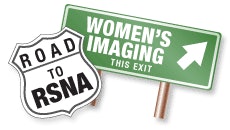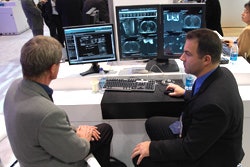At this year's RSNA conference, watch for presentations in women's imaging that explore ways to screen for breast cancer more effectively, according to breast imaging subcommittee member Constance Lehman, MD, PhD, section head of breast imaging at the University of Washington in Seattle.
"For breast imagers, there's continued drive in clinical research to find better methods for early breast cancer detection," Lehman told AuntMinnie.com. "Although we strongly recommend annual mammographic screening for women age 40 and older, we do know that mammography is imperfect and we are striving to find better methods of screening."
Attendees can check out two "Hot Topic" presentations at the conference: One will explore the use of digital breast tomosynthesis as a breast imaging technique (Wednesday, December 1, SH40, 7:15 a.m-8:15 a.m., Room E351), and another will examine national and international perspectives on screening mammography (Thursday, December 2, SH53, 3:00 p.m.-4:00 p.m., Room E353C).
Also at the RSNA meeting, breast MRI's capabilities will be highlighted, Lehman said, with papers focusing on how preoperative breast MRI affects patient outcomes and how MRI can be used as a screening tool for women at increased risk of breast cancer.

Also of interest on the breast MRI front during the conference will be studies on new applications of the technology, including diffusion MRI, which doesn't require contrast, but rather measures the movement of water within different types of breast tissue and may improve MRI's specificity in breast imaging, according to Lehman.
"Diffusion MRI has been used in brain imaging, and there are very exciting applications for it with breast cancer," she said. "Diffusion MRI gives more information about the breast tissue and, as such, can improve MRI's specificity, therefore helping to guide clinicians' final biopsy decisions. And if breast MRI is ever to be used as a screening tool, having a way to use it that is fast, does not use contrast, and is easier to read would be much more feasible."
Also highlighted will be advanced imaging technologies, such as FDG-PET and breast-specific gamma imaging (BSGI), that offer not only anatomic information but also functional data such as how a tumor is behaving and what is feeding it -- which, in turn, can lead to more targeted breast cancer therapy. (Take a look at multisession course VM21, being held on Monday, November 29, from 8:30 a.m.-12:00 p.m. in the Arie Crown Theater.)
Finally, attendees will be able to view a number of posters that address specific breast cancer features and how to identify them with various imaging modalities (see posters LL-BRE2042, LL-BRE3273, and LL-BRE3274). And in the computer-aided detection (CAD) arena, a refresher course called "New Trends in Breast CAD" will be offered on Tuesday, November 30 (RC321A, B, and C; 8:30 a.m.-10:00 a.m.; Room S503AB).
Read on for more highlights of some of the more intriguing women's imaging papers scheduled for presentation at this year's RSNA meeting. To view the RSNA's listing of abstracts for this year's scientific and educational program, click here.



















